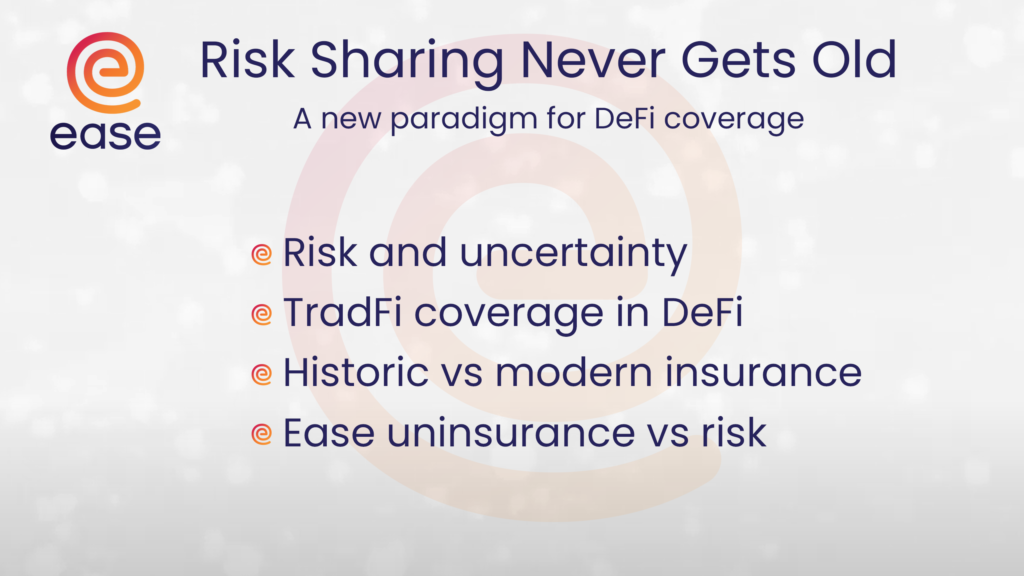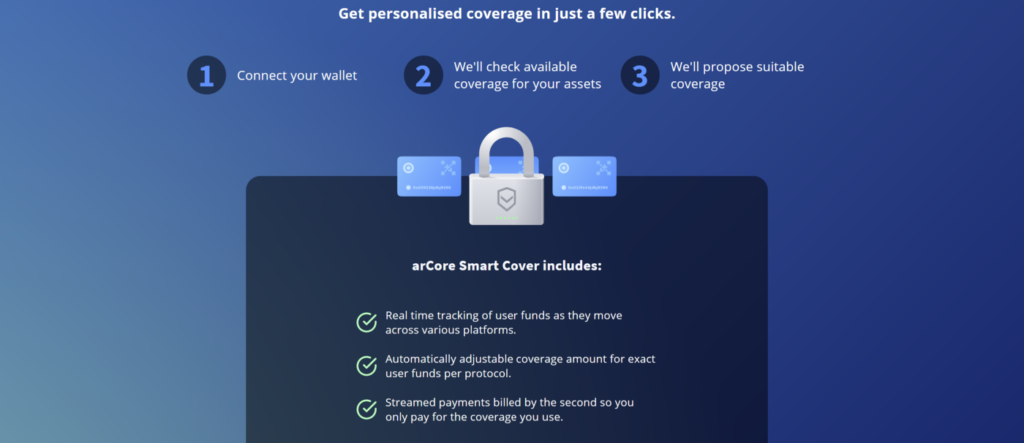A new paradigm for DeFi coverage
Introduction
From time immemorial, entrepreneurs are using insurance to cope with risk and uncertainty. Even modern crypto teams are used to the modern TradFi insurance model and they were fast to reinstate it on the blockchain. Therefore, most DeFi coverage protocols rely on Legacy concepts to provide coverage in the crypto space.
But is it really fitting or even adequate? Both the evolution of the insurance practice and the historical data so far strongly suggests the current TradFi-inspired model won’t live up to our initial expectations.
There may be another, more fundamental coverage model that’s more applicable in the crypto-verse.
Risk and uncertainty
In insurance terms, “Risk” is an event that is statistically predictable. Unknown events, for which no sufficient statistical data exists, are unpredictable. Hence they are called uncertainty.
One is able to anticipate risk and can therefore more easily prepare for it. Therefore, risk is easier to cover. However, unknown events don’t give coverage providers any chance of anticipation. Trying to cover uncertainty with the wrong model can easily end in failure in the long run.
The evolution of insurance practices developed simultaneously with the increase of available data and experience of entrepreneurs. As uncertainty turned into statistical risk, the more primal coverage models gave way to the more sophisticated contemporary methods used in TradFi.
Fiat risk vs crypto uncertainty
It’s easy to cover a risky environment when a lot of historical observations and data are available, like in the old fiat financial system. Old money has been thoroughly explored and has arguably reached the peak of its development.
The TradFi premiums-based model offers many sophisticated, battle-tested tools to apply to known risks. Because of that, it also offers easy and extensive profits for those involved.

Crypto, however, is out of sync with the currently used coverage methods.
The blockchain gave birth to a whole new world of never seen financial functionalities and possibilities. To call crypto young is an understatement. Promising its users financial freedom from the corrupt Legacy regulation, crypto is still far from mass adoption. Thus it likely offers maximum diversity of use cases and innovation.
In other words, this new environment is full of uncertainty.
Compared with the total DeFi market cap, the amount of DeFi assets that are currently covered is puny. Crypto adopters generally have riskier behaviour, but even if DeFi coverage was more popular, capacity would restrict the amount of available coverage.
TradFi coverage in DeFi
Quoting Hugh Karp (Nexus Mutual) and Dan Thompson (InsurAce), the traditional model simply can’t cover everything. If good security practices don’t become the norm in the crypto space, traditional insurance can’t solve the problem. Rather, premium-based coverage may only work for the more extreme risks, given there’s enough capacity.
But capacity is only one of all the challenges the TradFi model faces in the uncertain DeFi environment:
- DeFi developers are constantly bringing something new out of the void. Nobody can really know what vulnerabilities are associated with every new use case, functionality and project.
- Already known DeFi products, as well as the underlying protocols and networks they were built for, are constantly upgrading and evolving. Howerver, so are the skills of ingenious hackers out there.
- Known DeFi products build on top of each other, creating the so-called “stacked risk”. An incident in one protocol can start an avalanche of destruction.
So there is the unpredictability of innovation, both creative and destructive, and the “stacking” of risk. These make it virtually impossible for coverage providers to assess, price in, and therefore properly prepare for the vulnerabilities they cover.
Thus, the TradFi coverage method is not really applicable to crypto, except as a temporary band-aid. If thousands of years can teach us something about insurance, it’s that the success of a coverage model depends on its applicability to the risk environment.
Risk sharing
In the earliest stages of entrepreneurship, thousands of years ago, trade itself could be considered an uncertain environment. Numerous social, agricultural, political, and financial systems were yet to see their evolution. From this viewpoint, anything could happen to a daring trader. Entrepreneurs successfully relied on risk sharing to protect their businesses from predicaments.
The risk-sharing model has multiple forms, but it generally doesn’t rely on adequate risk anticipation or the pricing of risk. In many cases, it doesn’t even rely on capacity – another huge obstacle for the current coverage model in DeFi.
 Ancient Chinese traders spread their cargo to multiple ships. They were certain that a storm one day may sink a ship, but won’t sink a voyage spread over multiple ships and multiple days.
Ancient Chinese traders spread their cargo to multiple ships. They were certain that a storm one day may sink a ship, but won’t sink a voyage spread over multiple ships and multiple days.
Those Chinese traders didn’t pay premiums – in effect, they paid (suffered a loss) only if an event occurred and shared these costs between them. Additionally, they didn’t rely on coverage capacity, since the assets themselves were the collateral, namely, the ship’s cargo. They also did not rely on interest-bearing loans, which later systems used for security and which turned into premiums.
Caravan traders engaged in mutual assistance against pillaging and loss. They did this by jointly covering the losses of each one, contributing a fraction of their wealth to the risk capital of the venture.
Although primeval, when applied to uncertain environments, risk sharing is more successful than the more developed premium-based coverage models. Arguably, it’s because risk sharing was so successful in the early days, that with time uncertainty could be boiled down to statistical risk, leading to the development of modern insurance.
Modern insurance has its drawbacks
The TradFi premiums-based coverage model also has specific drawbacks unrelated to the uncertain crypto environment.
The first notion that the premiums model is akin to gambling arose as far back as the Middle Ages. Ever since, it’s been evident that in almost all cases, users pay premiums for a service they didn’t need in the end.
And even when a coverage claim is valid, there’s no 100% guarantee that the claim will be respected as a lot of shareholder interests are at play. TradFi Insurance companies are always incentivized to rake in the monthly premiums, but not to reimburse claimants when it’s due. Meaning – corruption.
Leverage only makes this more apparent, as the TradFi model has been intertwined with loans since the early days of insurance. Historically, the impossibility to retrieve funds in some risk situations pushed the industry to evolve in the direction of bonds, premiums and pre-paid systems.
Reinstating the same model on the blockchain, most premiums-based coverage providers must consider the interest of their leveraged risk assessors who seek profit for their risk.
Thus, Legacy model coverage providers may very well fall victim to the flaws of their model, while struggling with the overwhelming uncertainty of the DeFi environment. In the end, these coverage providers increase the risk in the ecosystem by being vulnerable to liquidation themselves.
Meanwhile, the ones buying the cover have a false sense of security and might invest in riskier assets than anticipated.
Ease Uninsurance
Ease believes that:
- Crypto innovations make insurance better – smart contracts make post-paid systems possible. They can lower the leverage in the system and the known incentives for corruption. Web3 allows insurance to outgrow the limited TradFi model and continue its evolution.
- Emergent risk is inherent in crypto, defining it as an uncertain environment. Therefore risk sharing is the only historically battle-tested model that can be adequately applied.
- Current coverage providers are not likely to have enough capacity to solve the security problem in DeFi based on the Legacy model. Capacity should be overcome to transcend its limitations.
- The pricing of emergent risks is a fool’s errand in an uncertain environment. A model that’s not dependent on this factor should be applied to make the coverage provider more resilient to unforeseen extreme events.
Respecting these beliefs, Ease explored the possibility of applying risk sharing in DeFi instead of the Legacy model. Based on the data previous hack history provides, we came up with a new service that’s much cheaper than the inadequately applied TradFi model. Plus, it’s theoretically unlimited in capacity.
We originally called this service Reciprocally Covered Assets, or RCA’s, as that is exactly what it entails. To honour how markedly different it is from the model fiat users are used to, we decided to rename it “Uninsurance”.
The Risk sharing model on the blockchain
Ease Uninsurance introduces risk-sharing coverage to the blockchain without any premiums.
When sharing risk, users are exposed not only to the risk of their own assets but also to the vulnerabilities of protocols that aren’t related to their investments. However, based on historical hack data, it’s way cheaper than other coverage protocols, as Uninsurance requires no premiums.
Until a hack event even occurs, users don’t pay anything for being covered.
With wise ecosystem management, executed by DAO voting and backed by the proprietary and very detailed Ease Risk Rubric, users may experience long uneventful periods of free coverage. The costs of rare hack events would be the cheapest the current crypto insurance industry can offer.
Thanks to our innovative tokenomics, the $Ease token offers the possibility of truly free coverage, even in the face of a hack event.
Staying true to original risk sharing, with Uninsurance the assets that are to be covered are also the collateral itself.
This effectively overcomes the limitation that capacity imposes on coverage. It’s now bound with demand – the more demand there is for coverage, the more capacity is available.
Crypto enables us to take a step back in the history of insurance, but take a huge leap forward as DeFi users!
No more battling with the emergent risk and its pricing and no more premiums. No more frustrating impossibilities and no more limits!
By adopting the Risk sharing mindset, Ease is a game changer in DeFi. Ease contributes to the further development of entrepreneurship in the space and mass adoption.
Ease – coverage that actually works in your favor!


